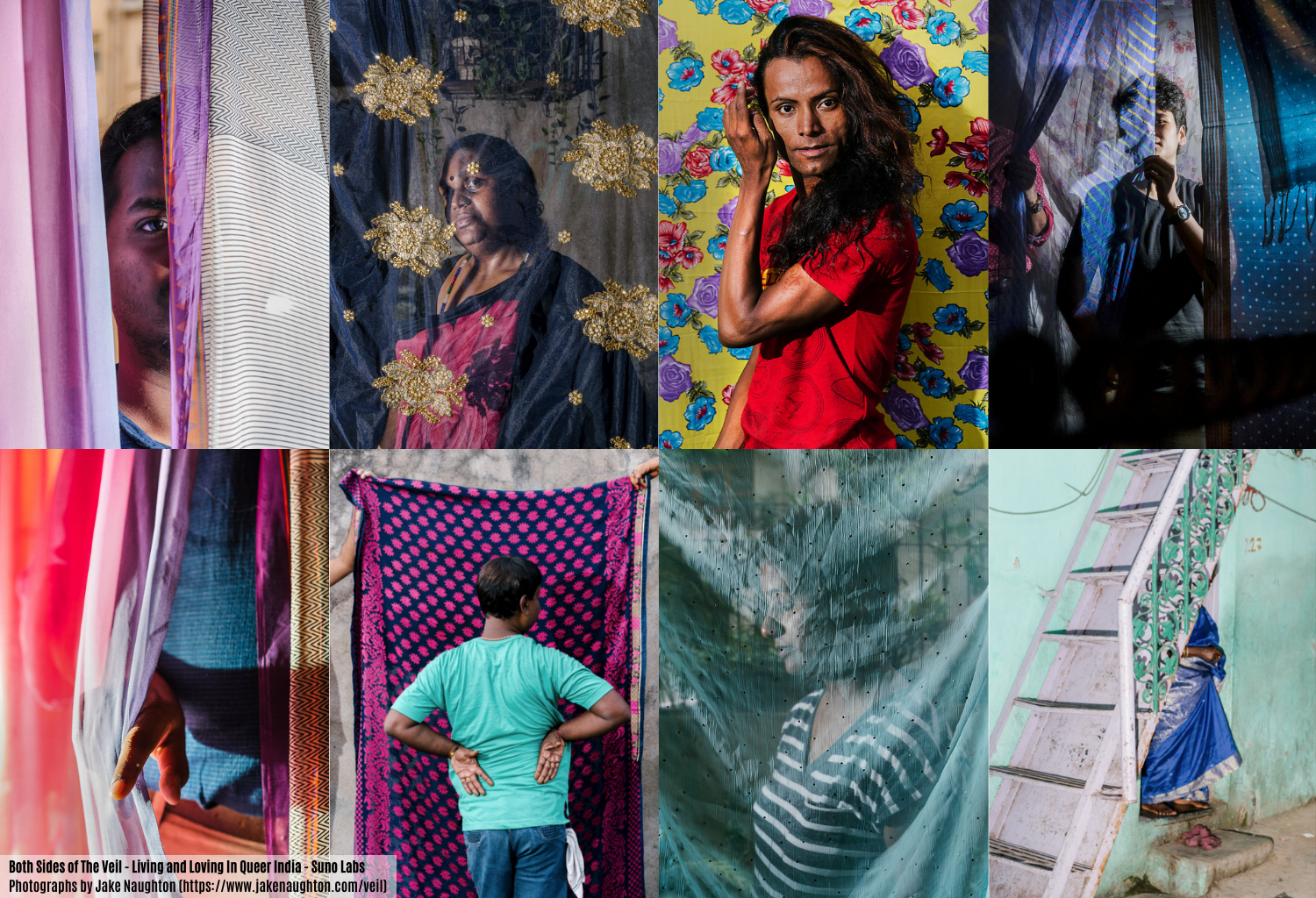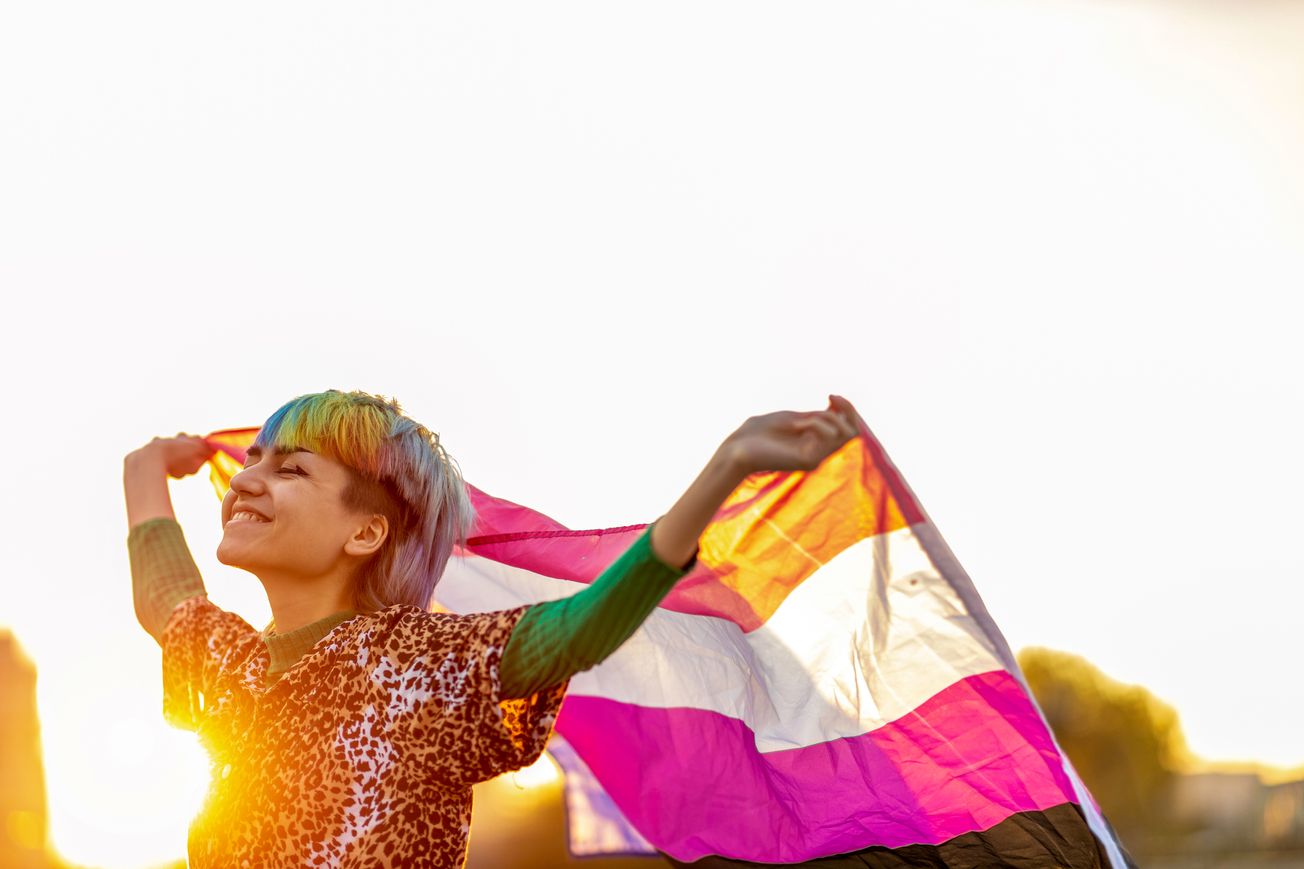Image Credits: Both Sides of The Veil - Living and Loving In Queer India - Suno Labs; Photographs by Jake Naughton (https://www.jakenaughton.com/veil)
As Indians with access to Western popular culture, many of us have grown up thinking of queerness as inherently white. It makes sense as for several years, the only representation Western mainstream media provided queer people with was stories of white, cisgender men struggling with their sexuality. From the undeniable classic Brokeback Mountain (2005) to Call Me by Your Name (2017), Hollywood movie arcs centred solely around white people coming of age while also coming to terms with being gay. It was also rare to see queer people in mainstream media, without their identity being subjected to excessive scrutiny and taking centre stage of the conflict in the story. Narratives centring BIPOC and genderqueer folks were largely ignored until the last few years when conversations surrounding diversity became louder and impossible to avoid.
This problem, however, has not been unique to the West. As mainstream media in India finally begins to showcase queer stories, the focus remains limited to upper caste cisgender narratives. Genderqueer and oppressed caste people are largely excluded from Bollywood, which has come nowhere close to being caste conscious. A singular queer narrative, with an emphasis on coming out, is portrayed with not even a trace of awareness of how intersections of identities shapes the lives of people from marginalised castes and those living in rural India.
While in 2021, there have been no “LGBTQ releases” in Bollywood so far, 2019 and 2020 were very significant for queer representation in the Indian film industry. The release of Ek Ladki ko Dekha and Shubh Mangal Zyaada Savdhaan aimed to normalise queerness for a wider audience that wasn't used to seeing it on the big screen. Both these films were based in small towns rather than in larger urban centres—which was refreshing—however, the happy endings and acceptance they portrayed depicted the kind of privilege and idealism that seemed too far from reality. There is no doubt that joyous narratives bring positive affirmation but they also feed the illusion that the things are improving rapidly for queer people in India. “Far away from gay pride parades, meet-ups and heated discussions on Twitter,” according to Rashmi Patel, the experience of LGBT individuals remains fraught with life-threatening challenges.
“In some parts, secret honour killings are planned so that the only way for a young gay man to survive is to run away in the cover of the night to some city, with no money or social support. In other parts, lesbian women are subjected to family-sanctioned corrective rapes, which are often perpetrated by their own family members.”
The myth of queer affluence is known to impede progress towards equality. In popular Indian culture, queer narratives are further sanitised of references to caste violence and erasure that people face. Diversifying these narratives of queerness is necessary as media serves as a powerful means of creating dialogue.
The casteism and cis privilege reflected in mainstream media are, sadly, very much a part of the Indian LGBTQ+ community itself—a space that is supposed to be for “everyone”.
Last month was Pride month and, as usual, we saw a flurry of rainbows, heart-warming stories, and interviews with LGBTQ+ people in the bubble of social media platforms. (It’s important to remember that only 32.3% of the total Indian population, primarily in eight metropolitan cities have access to social media). The number of social media users decrease as we move to smaller towns, especially for women, who are already only about half of the population online. The queer narratives we see on social media are skewed as they disproportionately represent people from larger urban centres. Furthermore, the stories highlighted are once again primarily those of privileged activists and influencers who, more than anything, benefit as individuals by play up their queerness.
It is important to take a step back and wonder how much value these narratives add to the bigger conversation. As an example, let’s consider how my own assertions as an LGBTQ+ activist compare to those of Kiran Yadav, a lesbian woman based in rural Bihar. I came out as pansexual at the age of fourteen to be met with complete acceptance, while Yadav knows well that coming out to anyone would have disastrous consequences due to the social stigma around her. Yadav tried to kill herself when she turned thirty and says she has no hope of finding a partner since she cannot be open about her sexuality. I celebrated the 2018 ruling against Section 377 with my friends in the city, while Yadav says she didn’t even know what the ruling was about or even that homosexuality wasn’t legal. How does my celebration of queerness look when seen alongside the hopelessness that Yadav feels?
The celebration of queer identity is, unfortunately, an urban phenomenon limited to the upwardly mobile in India. When we watch films surrounding queerness, when our Instagram feeds are filled with rainbows and listicles about LGBTQ+ creators, it’s easy to convince ourselves that things are changing for the better. The idea of ‘coming out’ in itself is a very urban middle class-centric construct, according to queer scholar Akansha, who says it presumes access to sociality that has room for understanding what coming out means.
“In rural spaces, there have always been registers of how you navigate queerness—for example, lesbians were often colloquially referred to as pakki saheliyan. If we go to these settings with urban modalities of queer expression to make sense of things, we will find ourselves completely fooled.”
Privilege plays an important role in opening up the world of an LGBTQ+ person. Pride events and afterparties held at exclusive venues of glitter and rainbow are far from the reality for people in marginalised communities who live in the fear of their queer identities being discovered. Simply embracing their queer identity is tough leave alone attending extravagant celebrations or making assertive social media posts.
At a recent Pride event in Bengaluru, the organisers played pop hits from the West, alienating much of the local trans community—a fine example of how out of tune the upwardly mobile organisers of the event are with large parts of the LGBTQ+ population.
This is not to say that suffering or disenfranchisement are required for truly qualifying as LGBTQ+ but a reminder that it is important to center those who find themselves excluded not only from the narratives of mainstream media but also from the urban, social media led LGBTQ+ movement. As for the new but very limited trend of corporate-sponsored holiday of rainbows—it is bound to leave marginalised queer folx behind.
The dangers of treating the queer experience as singular and monolithic are many. To see Pride as just a celebration is reductive and detrimental to the movement that still requires a lot of work to be done. Pride as rebellion is political. As queer individuals whose privilege allows us to celebrate Pride, we should not forget that no one is free until everyone is.










